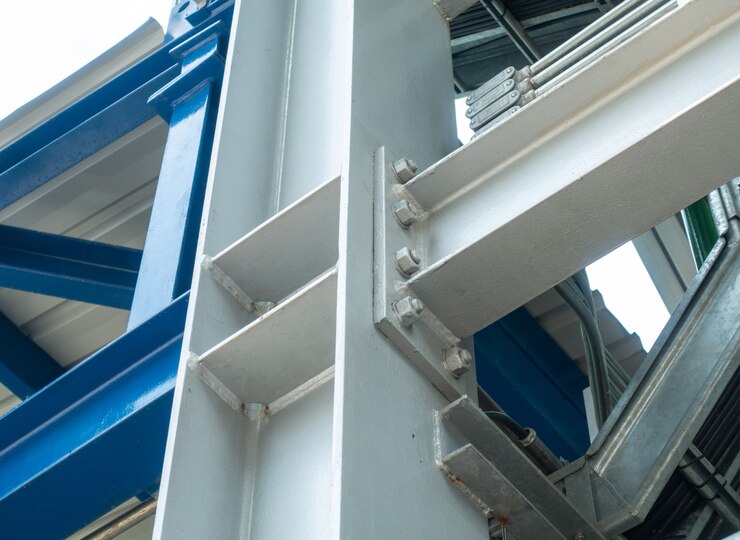The B&N system is a reliable system for the construction of steel structures, and it has been used for many decades. In this system, beams and columns are prefabricated at a factory from steel sheets or normal profiles and transported to the site. On the site, these elements are assembled using bolts and nuts. To reduce the weight of structure, AAC blocks or 3D or LSF panels could be used for panel wall construction jobs.

What are the different types of nuts and bolts?
What does a bolt look like?
Let’s start with a nuts-and-bolts definition. Bolts are threaded fasteners with external male threads. They mate with nuts, which have female – meaning, internal – threads.
What are nuts used for?
Both the bolt and the nut grip the materials being fastened, creating a bolt joint, with the nut also preventing axial movement. The effect of the bolt joint comes down to the axial clamping force provided by the nut and the shank of the bolt, which acts as a rod that presses the joint against sideways shear forces. This is why so many bolt shanks are threadless – it makes for a stronger rod.
When to use bolts vs screws
It’s often assumed that the difference between bolts and screws lies in the tools used to install each – a screwdriver for a screw and a wrench for a bolt. This isn’t always the case, however. Bolts can have heads that we associate with screws and require a screwdriver for installation. Even some screws use nuts, so we’re dealing with grey areas.
_Nut&Bolt.jpg)
There are so many different bolts and screws and some share similarities. Where they differ in general terms will help you decide which one to use:
| Bolts | Screws |
| Non-tapered | Tapered |
| Uses a nut and washer | Uses a washer and sometimes a nut |
| Threads provide stronger holding power | Threads provide sure grip |
| Best for heavy-duty applications | Best for lighter applications |
The decision of which you choose really comes down to the application and the materials you’re fastening. For lightweight materials, such as plastics, plywood and drywall, screws are best. Most of the time, that is. Bolts also come in plastics, but these are mostly used for electronics, as they’re lightweight, corrosion resistant and provide excellent insulation.
For heavy-duty applications and heavier materials, such as concrete and metals, go with bolts.
Types of bolt heads
Bolt head styles are designed for the bolt’s intended function while enabling the installation tool to grip the head. Below are examples of different types of bolt heads. As seen here, bolts can have slots or drives, just as screws do.
Bolt head identification chart

Hex Can be grabbed by tools from all angles and if necessary, even installed by hand. Many different bolt heads incorporate a hex design. |
 DomedThese decorative bolt heads are difficult to wrench externally, which adds a level of security |
Bent The example shown here is an eye bolt for lifting, but bolts are available in other shapes for speciality applications. |
|
Square Enables an easy grip for wrenches for tightening nuts.
|
Pentagon Designed to resist tampering by not accommodating torx and hex tools. |
Flat Flat head bolts are countersunk, which enables them to save space on applications. |
Bolt identification guide
What are different types of bolts? Each bolt is designed for specific applications. Below are bolt descriptions to give you an idea of their capabilities:
Bolt types
|
Anchor Used in the construction industry to secure a structural component to a concrete slab or poured foundation.
|
Blind For structural applications where access is restricted to one side, enabling the lock to still be completed. |
Double end A bolt with threads on both ends, also called stud bolts. Used to fasten two flanges or pipes more effectively. |
|
Carriage A self-locking bolt with a domed head and square section underneath. Used mostly in hinges and locks to provide a level of security, permitting removal from the bolt’s nut side. |
Eye Used for lifting applications. Some are designed for heavy loads while others are for non-load bearing uses. |
Hex Characterised by its six-sided head, there are many different types of hex bolts. Typically used in machinery and construction applications and available fully or partially threaded. |
|
Penta-head Highly specialized bolt with five-sided head. Typically used for security on manhole covers and ground lids. |
Shoulder Performs as a shaft or axle that can hold a rotating part, such as a bearing. Also called a shoulder screw and stripping bolt. |
T Head Also known as a T-slot. Inserts into a recess and with the applied nut, the bolt is secured against turning. Common in construction and automotive. |
|
U-bolt Functions in applications ranging from supporting pipes to use on automotive drive shafts and exhaust systems. |
J-Bolt Also referred to as a hook bolt and typically used in structural applications, such as roofing and securing walls to concrete foundations. |
Elevator Named after its original use in grain elevator systems. Today it’s used on assembly lines, furniture and various consumer products. Large circular head and low profile provides generous clearance |
|
Flange The flange acts as a washer to distribute the load. Commonly used to connect plumbing pipes, a vehicle’s transmission and engine and other mechanical applications. |
Hanger Connects two surfaces while hiding the bolt. Often used to suspend electrical conduits, fixtures and sheet metal. |
Lag Also known as lag screws, these bolts are typically used to connect heavy lumber and lag machinery to wood floors. |
Guide to nuts
The vast majority of nuts, no matter what type, are hex shaped. This is because the six sides make it easy to turn. It only takes a one-sixth turn for the nut to reach the next flat parallel. A nut with fewer sides takes more time to install. Other shapes are available, which are for specific needs.
Types of nut fasteners
|
Protects bolt threads underneath while presenting a clean appearance. Also can prevent skin and clothes from snagging on sharp edges. |
Acorn A type of cap nut with the same capabilities. Named after its head, which is shaped like an acorn. Cap nuts are used across all industries and also resist vibration. |
The side wings enable quick, easy tightening and removal by hand. For this reason, it should not be used if vibration is present. |
|
Jam Low-profile nuts that, when jammed into place against a standard nut, prevents loosening. Also used when a standard nut won’t fit. |
The flange serves the purpose of a washer, evenly distributing the load. Typically used in the automotive sector on exhausts. |
Coupling While not typically a bolt nut, these are used for connecting threaded rods or pipes together. |
|
Insert creates friction, resulting in a gripping action and reducing chance of loosening due to vibration. Commonly used in white goods, computers and vehicles |
Square A type of blind nut, its shape means that more of its surface is in contact with the material being, which reduces the chances of it loosening. Typically used with square-headed bolts. |
Different types of hex nuts all provide a reliable hold. Easy to tighten and loosen due to its shape. Used in applications across all industries, from automotive to machinery. |
|
Tee For fastening soft materials such as wood or plastic. The flange on one side has hooks, which latch onto the material being fastened to strengthen the joint and leave a flush surface. |
Slotted Secured using a cotter pin or wire to prevent rotation. Typically used in applications where vibration is a constant threat. |
Castle The turret geometry on the castle nut differentiates this from the slotted nut. Their functions and how they work are the same |
|
Keps-K lock nuts Designed for easy assembly. The attached free-spinning serrated washer creates tension against the material’s surface when installed onto a bolt. Note: overtightening will cause the nut to fail. |
Prevailing torque nut The distortion of the top threads creates locking action, which causes the nut to resist loosening due to shock and vibration. They are installed with the conical top up, which makes these one-way lock nuts. |
Plastic push-on nut is applied to a threaded bolt and tightened manually or with a spanner or other tool. It can only be loosened with a wrench. Used when quick assembly is a priority. |
Why use washers with nuts and bolts?
For the same reason you use them with screws. Technically you don’t need washers for nuts and bolts, but we recommend that you still use them.
How do washers work with bolts?
Washers evenly distribute the nut’s load and protect the surface that you’re fastening from damage. It also gives your nut a smooth surface to push against, which helps the fasteners remain tight instead of loosening. In a few cases, you’ll need to put the washer on the bolt side, but only if it’s the bolt that requires turning.
How to choose the right nut for your bolt
Nuts and bolts fasten together with their threads. The weakest shear plane in the thread profile is where failure can start. That is, the weakest material determines the strength of the connection. The point is, nuts and bolts should be made of the same alloys. Not only that, but your nut should meet or exceed the maximum tensile strength of the bolt, which is the amount of pull the bolt can withstand.
If safety is a key consideration in your application, then you want your nut to be stronger than your bolt. In these instances, the Industrial Fastener Institute (IFI) recommends that your nut should exceed your bolt’s tensile strength by 20%.
How to tell the grade of a bolt
Bolt grades indicate the strength of your fastener. Understanding bolt grades is critical to choosing the right fastener. Typically, identification markings on bolt heads include the grade and the manufacturer’s mark. The grades are indicated by raised dashes or numbers.
How are bolts graded? The primary systems are:
| SAE | Society of Automotive Engineers. SAE bolt head markings use a series of raised dashes to communicate strength. How to identify grade 8 bolts? See the chart below. |
| Metric | Metric bolt grades are known as “property class,” and are set by the International Standards Organization (ISO). This system uses two numbers separated by a dot expressed in raised or depressed numbers either on the top or side of the bolt head. What does class 8.8 mean on the head of a bolt? The higher the ISO numbers, the stronger the bolt. |
| ASTM | The American Society for Testing and Materials (ASTM) indicates bolt material grades by the letter A and three numbers on the bolt head. |
Bolt grade guide
Let’s look at some common bolt grades. To help you understand the chart, you should know that:
- U.S. systems measure strength according to pounds per square inch (psi).
- The metric system uses megapascals (MPa), a pascal unit of measurement for internal stress required to break the bolt.
- Proof load is the limit of the bolt’s elastic range. Steel is regarded as an ‘elastic’ material in that it stretches a tiny bit when the bolt is tightened.
- Yield strength is the tensile strength that will cause permanent deformation.
- Tensile strength is the maximum force a bolt can withstand before breaking. Pay especial attention to this line on any bolt strength chart.
U.S. bolt grades: SAE
| Bolt head markings: | Grade/Material/Size (inches) | Proof load (psi) | Minimum yield strength (psi) | Minimum tensile strength (psi) |
 |
Grade 2 (no marking) Low strength
Low or medium carbon steel ¼” – ¾” |
55,000 | 57,000 | 74,000 |
 |
Grade 5
Medium strength Medium carbon steel, quenched & tempered ¼”– 1″ |
85,000 | 92,000 | 120,000 |
| Over 1″– 1½” | 74,000 | 81,000 | 105,000 | |
 |
Grade 8
High strength Medium carbon alloy steel, quenched & tempered ¼” – 1½” |
120,000 | 130,000 | 150,000 |
U.S. bolt grades: ASTM
| Bolt head markings: | Grade/Material/Size (inches) | Proof load (psi) | Minimum yield strength (psi) | Minimum tensile strength (psi) |
 |
Grade A307
Low carbon steel ¼”– 4″ |
— |
— |
60,000 |
 |
Grade A325(type3)
Carbon or alloy steel with or without boron ½” –1½” |
85,000 | 92,000 | 120,000 |
 |
Grade A354 BD
Alloy steel, quenched & tempered ¼” – 4″ |
120,000 | 120,000 | 150,000 |
Metric bolt grade identification
| Look for: | Class/Material/Size | Proof load (MPa) | Minimum yield strength (MPa) | Minimum tensile strength (MPa) |
 |
Class 8.8
Medium carbon steel, quenched and tempered Up to 16mm |
580 |
640 |
800 |
| 16mm – 72 mm | 600 | 660 | 830 | |
 |
Class 10.9
Alloy steel, quenched and tempered 5mm – 100mm |
830 | 940 | 1040 |
 |
Class 12.9
Alloy steel, quenched and tempered 1.6mm – 100mm |
970 | 1100 | 1220 |
| Usually marked
A2 or A4 |
A2 & A4 Stainless steel
alloy with chromium and nickel Up to 20mm |
— | 210 min.,
450 typical |
500 min.,
700 typical |
Nut grades explained
In the metric system, a single number on a hex nut indicates its property class. A nut’s number is around 1/100 of the minimum tensile strength in MPa. A nut in property class 9 has a minimum tensile strength of 900 MPa. This number corresponds with its compatible class of bolt:
Metric
| Nut property class | 5 | 6 | 8 | 9 | 10 | 12 |
| Matching bolt property class | 5.8 | 6.8 | 8.8 | 9.8 | 10.9 | 12.9 |
In the SAE system, you’ll notice in the table above that a Grade 2 bolt is not required to have any marking, as it has low tensile strength. Grade 5 bolts are typically used in automotive applications. Grade 8 bolts are for heavy-duty applications.
Nuts have “clock markings.” In the examples below, the circumference line between the line and the dot in a grade B nut is 120˚. For a grade C nut, it’s 60˚. Sometimes, the nuts are referred to as Grades 2, 5 and 8 to correspond with their compatible bolts.

Grade A nut (no marking required) |

Grade B nut |

Grade C nut |
SAE
| Nut grade | Grade A | Grade B | Grade C |
| Matching bolt grade | Grade 2 | Grade 5 | Grade 8 |
ASTM
ASTM A563 is a standard material specification for carbon and alloy steel nuts for bolts used on general structural and mechanical applications. The hex bolt grade markings are as follows:

No marking – Grades O, A & B |

Grade C |

Grade C3 |

Grade D |

Grade DH |

Grade DH3 |
| Compatible bolts | |||||
| A307 and
SAE Grade 2 |
A325,
A354 and SAE Grade 5 |
SAE Grade 5 | A325 and
SAE Grade 8 |
A325 and
SAE Grade 8 |
SAE Grade 8 |
Parts of a bolt
Understanding the anatomy of a bolt will help you choose what you need.
Thread: The helical ridges that spiral around the body and engages with the nut.
Runout: The point on the bolt that “runs out” of thread and where the shank begins.
Shank: The smooth, threadless part of the bolt.
Radius: The curve between the shank and the head.
Head: The part of the bolt that a torque tool can hold for tightening or loosening.
Thread length: The length of the thread, which
varies according to its intended purpose.
Grip length: Also known as clamped length. Should equal the total thickness of the materials being joined.
Nominal length: The total of thread length plus grip length.

Bolt sizes
The American Society of Mechanical Engineers (ASME) has set the standard specifications for bolts. Bolts are available as coarse thread (UNC) or fine thread (UNF). To know how to size a bolt, including how to measure metric bolts and U.S. standard bolts, you need to understand thread standards and definitions, as illustrated here:

Major diameter: Diameter of the imaginary cylinder from the top of an external thread.
Minor diameter: Diameter of an imaginary cylinder from the thread’s groove.
Crest: Prominent part of the thread.
Root: Bottom of the groove between the two flanking surfaces of the thread.
Flanks: Straight sides that connect the crest and the root.
Thread angle: Angle between the flanks.
Pitch: Distance, measured parallel to its axis, between corresponding points on adjacent surfaces.
How to measure bolt length
If the bolt’s head will sit above the surface to which it’s installed, then measure the nominal length. If the bolt’s head is countersunk – meaning, it will sit flush to the surface – then measure from the top of the head to the end of the bolt.
How to find the thread size of a bolt
Use the following equations to calculate dimensions for Unified Inch threads – dnom is nominal diameter in inches and TPI is threads per inch.
| Equation, US Units [in] | Source | |
| Minor Diameter | dm.ext = dnom − 1.299038/TPI | Machinery’s Handbook |
| Pitch Diameter | dp.ext = dnom − 0.64951905/TPI | ASME B1.1, Section 10.1p |
| Nominal Area |  |
N/A |
| Tensile Stress Area |  |
ASME B1.1, Appendix B |
| Minor Area (Shear Area) |
 |
N/A |
Bolt thread length
To find the length of machine bolt threads, use the equation below, where L is the total bolt length and dnom is the nominal bolt diameter. Per ASME B18.2.1, the nominal thread length of inch-series bolts can be found by:

Hex nut dimensions
The following equations can be used to calculate internal thread dimensions for Unified Inch threads. Note: dnom is nominal diameter in inches and TPI is threads per inch.
| Equation, US Units [in] | Source | |
| Minor Diameter | dm.int = dnom − 1.08253175/TPI | ASME B1.1, Section 10.1s |
| Pitch Diameter | dp.int = dnom − 0.64951905/TPI | ASME B1.1, Section 8.3 |
Metric bolt and nut dimensions
Bolt Thread Dimensions
The following equations can be used to calculate dimensions for ISO metric threads. The thread profile is based on a parameter H, which is the height of the fundamental triangle. The value of H is related to the thread pitch, P, by:

Below, dnom is nominal diameter in millimetres and P is the thread pitch in millimetres.
| Equation, Metric Units [mm] | Source | |
| Minor Diameter | dm.ext = dnom − 1.226869P | Shigley |
| Pitch Diameter | dp.ext = dnom − 0.75H = dnom − 0.64951905P | Machinery’s Handbook |
| Nominal Area |  |
N/A |
| Tensile Stress Area |  |
ASME B1.13M, Appendix B |
| Minor Area (Shear Area) |
 |
N/A |
Bolt Thread Length
Per ASME B18.2.3.1M, Table 7, “Thread Lengths,” the nominal thread length of metric bolts can be determined by the equation below, where L is the total bolt length and dnom is the nominal bolt diameter.

Hex nut internal thread dimensions
The following equations can be used to calculate internal thread dimensions for ISO metric threads dnom is nominal diameter in millimetres and P is the thread pitch in millimetres.
| Equation, Metric Units [mm] | Source | |
| Minor Diameter | dm.int = dnom − 1.25H = dnom − 1.08253175P | Machinery’s Handbook |
| Pitch Diameter | dp.int = dnom − 0.75H = dnom − 0.64951905P | Machinery’s Handbook |






































No comment